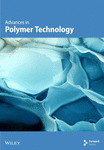Modeling of mixing in internal mixers with long blade tips
Abstract
It is well known that blade geometry significantly affects the performance and efficiency of partially filled internal mixers. Intermesh type blades with very long tips are regarded as effective alternatives to almond-shaped blades used in more traditional tangential rotor mixers. However, using long tip blades results in the formation of long and very narrow sections between the chamber wall and the blade in these mixers. These narrow sections may act as bottlenecks, disrupting flow and mixing of highly viscous compounds in the mixing of elastomers with fillers. Therefore, to avoid costly and time-consuming trial-and-error procedures, the design of long tip blades requires careful quantitative evaluation of their performance. In this article, a computer model, based on the finite element method for the simulation of mixing in twin-blade intermesh type mixers, is presented. This model represents transient, nonisothermal, non-Newtonian flow and mixing of a polymer–filler compound in a free surface regime consisting of incompressible and compressible parts. Mixing dependent variations of compound viscosity are also taken into account. To incorporate all of the described realistic aspects of the mixing process in the geometrically complex domain of intermesh type mixers, the developed model is based on a novel and robust solution algorithm. © 2001 John Wiley & Sons, Inc. Adv Polym Techn 20: 132–145, 2001




